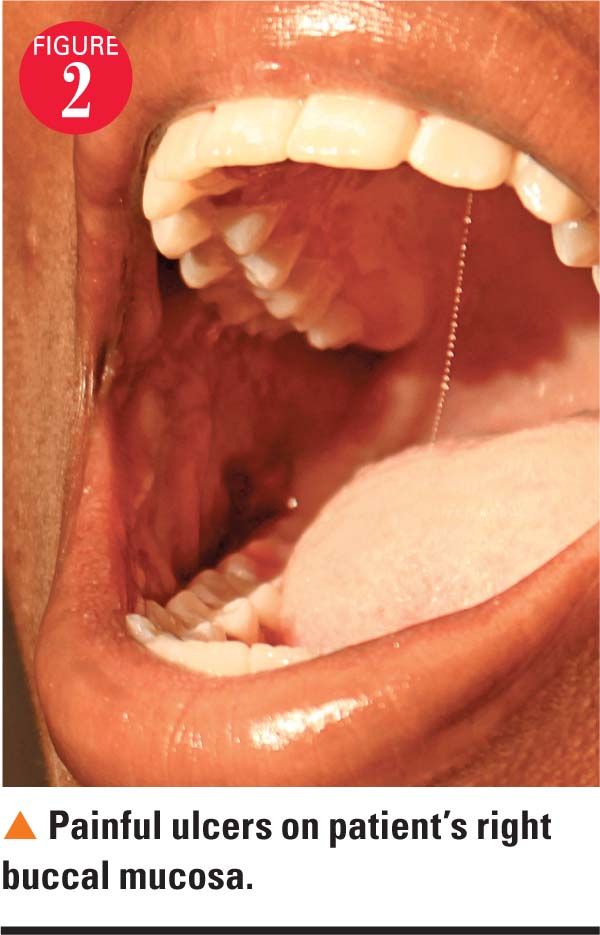Painful lesions target girl’s hands, feet, and mouth
The mother of a 16-year-old girl brings her to the office for evaluation of a painful rash on her hands and feet and oral ulcers that make it difficult to eat and drink.

THE CASE
The mother of a 16-year-old girl brings her to the office for evaluation of a painful rash on her hands and feet and oral ulcers that make it difficult to eat and drink. The teenager had similar episodes 3 and 6 months earlier, and she recalls a cold sore shortly before each outbreak. The mother is afraid that her daughter will become dehydrated and require hospitalization. FOR MORE ON THIS CASE, CLICK NEXT.
DERMCASE diagnosis: RECURRENT ERYTHEMA MULTIFORME

Erythema multiforme (EM) is considered to be a type IV hypersensitivity reaction to infectious etiologies and medications, as well as several other triggers.1 It is characterized by a symmetric eruption of red papules and/or urticarial plaques that enlarge centrifugally over 2 to 3 days forming the classic “target lesions.” Target lesions are characterized by at least 3 distinct zones, 2 of which show distinctive color change surrounding a central area of necrosis with crusting or blister formation. These lesions can expand up to 2 to 3 cm in diameter and generally resolve after 1 to 2 weeks.2 The most common locations are extensor surfaces of upper extremities and the face, but the palms, soles, and trunk also may be involved. Up to 50% of patients may have mucosal involvement of the buccal mucosa.3
Etiology
Recurrent lesions are often related to infectious etiologies, the most common being herpes simplex virus (HSV).2 In most cases where this is the causative agent, polymerase chain reaction will detect virus from the skin lesions. Several studies have quoted rates of HSV-triggered recurrent EM anywhere from 23% to 100% of patients.3 Less-common infectious etiologies include infection with Mycoplasma pneumoniae.
Differential diagnosis
The differential diagnosis should include HSV, urticaria, allergic vasculitis, bullous pemphigoid, bullous drug eruption, and reactive arthritis syndromes. Clinical course usually allows the clinician to distinguish these disorders from EM, but when necessary distinctive histologic findings of apoptosis of individual keratinocytes followed by mild spongiosis and vacuolar degeneration of the basal cell layer help to confirm the diagnosis.1
Treatment
Acutely, a 2- to 3-week tapering course of systemic steroids will clear the oral and cutaneous lesions, but this should be reserved for those patients with severe oral involvement at risk for dehydration. In cases of recurrent EM secondary to HSV specifically, but even in those cases without a clear cause, treatment with antiviral medications can be used to suppress recurrent viral triggers. Some studies have demonstrated success with continuous prophylactic acyclovir whereas others found valacyclovir to be more effective in reducing the rate of recurrence. More refractory cases may be treated with immunosuppression with corticosteroids, as well as with mycophenolate mofetil. Dapsone and hydroxychloroquine also have been used.1
The patient
Because of the preceding HSV lesions, the patient was started on treatment with acyclovir that will be followed by long-term prophylaxis. She was also treated with tapering oral steroids, which resulted in dramatic healing of skin and oral lesions within 72 hours.
REFERENCES
1. Wetter DA, Davis MD. Recurrent erythema multiforme: clinical characteristics, etiologic associations, and treatment in a series of 48 patients at Mayo Clinic, 2000 to 2007. J Am Acad Dermatol. 2010;62(1):45-53.
2. Liacouras CA. Normal digestive track phenomena. In: Kliegman RM, Stanton BF, St. Geme JW III, Schor NF, Behrman RE. Nelson Textbook of Pediatrics. 19th ed. Philadelphia, PA: Elsevier Saunders: 2011; 1240-1242.
3. Schofield JK, Tatnall FM, Leigh IM. Recurrent erythema multiforme: clinical features and treatment in a large series of patients. Br J Dermatol. 1993;128(5):542-545.
Dr Soukup received her medical school degree at the University of Maryland School of Medicine, Baltimore, and currently is pediatric chief resident at Sinai Hospital, Baltimore. Dr Cohen, section editor for Dermcase, is professor of pediatrics and dermatology, Johns Hopkins University School of Medicine, Baltimore, Maryland. The author and section editor have nothing to disclose in regard to affiliations with or financial interests in any organizations that may have an interest in any part of this article. Vignettes are based on real cases that have been modified to allow the author and section editor to focus on key teaching points. Images also may be edited or substituted for teaching purposes.
Recognize & Refer: Hemangiomas in pediatrics
July 17th 2019Contemporary Pediatrics sits down exclusively with Sheila Fallon Friedlander, MD, a professor dermatology and pediatrics, to discuss the one key condition for which she believes community pediatricians should be especially aware-hemangiomas.